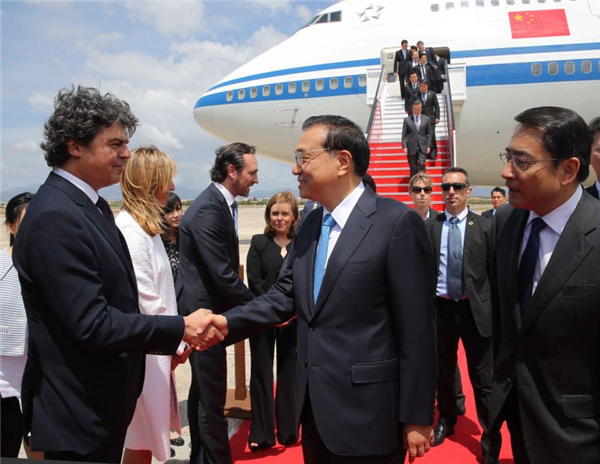
 |
|
Chinese Premier Li Keqiang, center, leaves Santiago de Chile Airport to return to China as he wraps up a nine-day visit to four Latin American countries, namely Brazil, Columbia, Peru and Chile, on May 26. On his way home, during a technical stop in the Spanish island of Mallorca on May 27, he held talks with Spanish Deputy Prime Minister Soraya Saenz de Santamaria. [Photo provided to chinadaily.com.cn] |
Weak international demand and low commodity prices have revealed the vulnerability of Latin America's economy. The region's annual growth rate is expected to be only 0.3 percent this year, the lowest among all economic blocs.
The Economic Commission for Latin America and the Caribbean and other international institutions have called for an urgent change in the region's development model away from dependence on the export of natural resources. But some observers say China's economic slowdown is to blame for Latin America's economic woes.
Is it true? Has China stopped buying from Latin America?
The fact is, China, with its growth rate of about 7 percent, is still the biggest contributor to global growth and has shown no sign of declining demand for commodities. According to the Chinese customs, from January to August this year, China's import of grains, copper and its related products, crude oil, and soybean increased by 24 percent, 12 percent, 10 percent and 24 percent.
Despite the fall in prices, which explains the 2.4 percent drop in the total import value, China's total import of commodities is still growing in terms of quantity. The decline in China-Latin America trade is mainly due to low prices in the world market and the depreciation of some Latin American countries' currencies against the US dollar. In fact, during the first nine months of this year, exports from Ecuador, Argentina and Uruguay to China grew by 15 percent, 5.3 percent and 15 percent.
China emphasizes a medium-to-high rate of economic growth, further opening up the economy and expediting urbanization. In the long run, the Chinese economy can still maintain a medium-to-high growth rate and its demand for commodities will remain stable, albeit with a tendency to grow.
But why have commodity prices declined?













